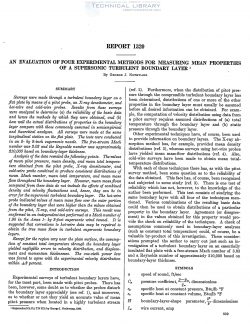naca-report-1320
- Version
- 217 Downloads
- 951.53 KB File Size
- 1 File Count
- November 2, 2016 Create Date
- November 2, 2016 Last Updated
National Advisory Committee for Aeronautics, Report - An Evaluation of Four Experimental Methods for Measuring Mean Properties of a Supersonic Turbulent Boundary Layer

Surveys were made through a turbulent boundary layer on a
flat plate by means of a pitot probe, an X—ray densitometer, and
hot-wire and cold-wire probes. Results from these surveys
were analyzed to determine (a) the reliability of the basic data
and hence the methods by which they were obtained, and (b)
how well the actual distributions of properties in the boundary
layer compare with those commonly assumed in semiempirical
and theoretical analyses. All surveys were made at the same
longitudinal station on the flat plate. The tests were conducted
in an 8- by 8-inch supersonic nozzle. The free—stream Mach
number was 3.03 and the Reynolds number was approximately
210,000 based on boundarywlayer thickness.
Analysis of the data revealed the following points. The values
of mean pitot pressure, mean density, and mean total tempera-
ture obtained from the pitot probe, X-ray densitometer, and
coldnm're probe combined to produce consistent distributions of
mean Mach number, mean total temperature, and mean mass
flow throughout “the boundary layer. However, mean mass flmvs
computed from these data do not include the eflects of combined
density and velocity fluctuations and, hence, they can be in
error for the supersonic turbulent boundary layer.
Surveys were made through a turbulent boundary layer on a
flat plate by means of a pitot probe, an X—ray densitometer, and
hot-wire and cold-wire probes. Results from these surveys
were analyzed to determine (a) the reliability of the basic data
and hence the methods by which they were obtained, and (b)
how well the actual distributions of properties in the boundary
layer compare with those commonly assumed in semiempirical
and theoretical analyses. All surveys were made at the same
longitudinal station on the flat plate. The tests were conducted
in an 8- by 8-inch supersonic nozzle. The free—stream Mach
number was 3.03 and the Reynolds number was approximately
210,000 based on boundarywlayer thickness.
Analysis of the data revealed the following points. The values
of mean pitot pressure, mean density, and mean total tempera-
ture obtained from the pitot probe, X-ray densitometer, and
coldnm're probe combined to produce consistent distributions of
mean Mach number, mean total temperature, and mean mass
flow throughout “the boundary layer. However, mean mass flmvs
computed from these data do not include the eflects of combined
density and velocity fluctuations and, hence, they can be in
error for the supersonic turbulent boundary layer. The hot-wire
probe indicated values of mean mass flow over the outer portion
of the boundary layer that were higher than the values obtained
from the pitot, X-ray, and cold-wire surveys. This result was
confirmed in an independent test performed at a Mach number of
1.95 in the Ames 1- by 3Joot supersonic wind tunnel. It is
suggested that corrections to hot-wire data may be required to
obtain the true mass flows in turbulent supersonic boundary
layers.
Except for the region very near the plate surface, the assump-
tion of constant total temperature through the boundary layer
yielded negligible errors in velocity distribution, and displace-
ment and momentum thicknesses. The one-sixth power law
was found to agree with the atpem'mental velocity distribution
within 5:2 percent.
The hot-wire
probe indicated values of mean mass flow over the outer portion
of the boundary layer that were higher than the values obtained
from the pitot, X-ray, and cold-wire surveys. This result was
confirmed in an independent test performed at a Mach number of
1.95 in the Ames 1- by 3Joot supersonic wind tunnel. It is
suggested that corrections to hot-wire data may be required to
obtain the true mass flows in turbulent supersonic boundary
layers.
Eaceptfor the region very near the plate surface, the assump-
tion of constant total temperature through the boundary layer
yielded negligible errors in velocity distribution, and displace-
ment and momentum thicknesses. The one-sixth power law
was found to agree with the atpem'mental velocity distribution
within 5:2 percent.
| File | Action |
|---|---|
| naca-report-1320 An Evaluation of Four Experimental Methods for Measuring Mean Properties of a Supersonic Turbulent Boundary Layer.pdf | Download |

Comment On This Post